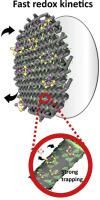Materials Today Energy ( IF 9.3 ) Pub Date : 2020-01-18 , DOI: 10.1016/j.mtener.2019.100380 Mei Er Pam , Shaozhuan Huang , Shuang Fan , Dechao Geng , Dezhi Kong , Song Chen , Meng Ding , Lu Guo , Lay Kee Ang , Hui Ying Yang

|
Owing to high aspect ratio of edge sites and superior catalytic activity, atomically thin transition metal dichalcogenides (TMDCs) show great promise to tailor the electrolyte/electrode interface properties for high performance lithium-sulfur battery (Li–S battery). However, the TMDCs that engineer the electrode/electrolyte interface are usually produced through chemical hydrothermal methods, which show low crystallinity and thick multilayer structure. Herein, a highly crystalline and atomically thin tungsten disulfides on carbon cloth (WS2@CC) was developed via chemical vapor deposition (CVD) and served as an effective electrode/electrolyte interface for Li–S battery. Our results demonstrate that the atomically thin WS2 with high crystal quality and abundant edges sites can effectively accelerates the redox kinetics of sulfur/lithium polysulfides and regulates the precipitation/decomposition of insoluble Li2S. More importantly, it was revealed that the hierarchical flower-stacked WS2 with excessive exposed catalytic edges shows extremely strong polysulfide adsorption, which causes the sulfur species aggregation and passivation on the WS2@CC surface, thus resulting in deformed rate performance and poor cycling stability as compared to the few-layer WS2@CC. Our work provides a new insight into the structural engineering of TMDCs by CVD for Li–S battery, and suggests the importance of rational chemisorption and catalysis of the interface to realize the high-performance Li–S battery.
中文翻译:

原子薄层二硫化钨催化剂用于高性能Li–S电池的界面工程
由于边缘位点的高长宽比和出色的催化活性,原子稀薄的过渡金属二硫化碳(TMDC)显示出为高性能锂硫电池(Li–S电池)定制电解质/电极界面特性的巨大希望。但是,设计电极/电解质界面的TMDC通常是通过化学水热方法生产的,该方法显示出较低的结晶度和较厚的多层结构。在此,通过化学气相沉积(CVD)在碳布(WS 2 @CC)上开发了高度结晶且原子薄的二硫化钨,并用作Li-S电池的有效电极/电解质界面。我们的结果表明,原子稀薄的WS 2具有高晶体质量和丰富边缘位点的金属可以有效地促进硫/多硫化锂的氧化还原动力学,并调节不溶性Li 2 S的沉淀/分解。更重要的是,揭示了带有过多暴露的催化边缘的分层花状WS 2示出非常强的多硫化物吸附,使硫物质聚集和WS上钝化2 @CC表面,从而导致变形率性能和差的循环稳定性相比,少层WS 2@CC。我们的工作为Li-S电池的CVD TMDCs的结构工程提供了新的见解,并提出了合理化学吸附和界面催化对实现高性能Li-S电池的重要性。


























 京公网安备 11010802027423号
京公网安备 11010802027423号